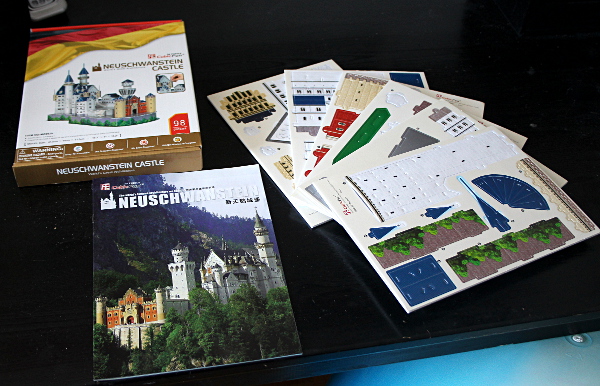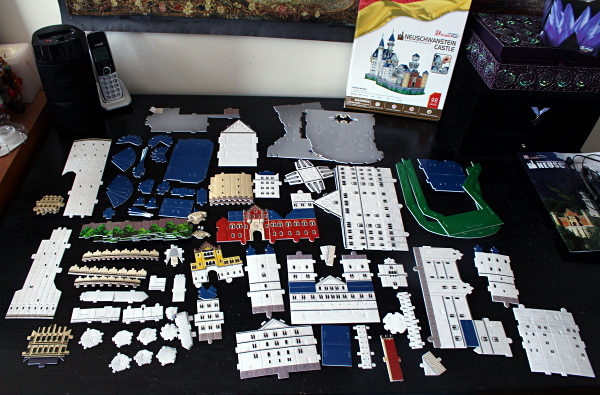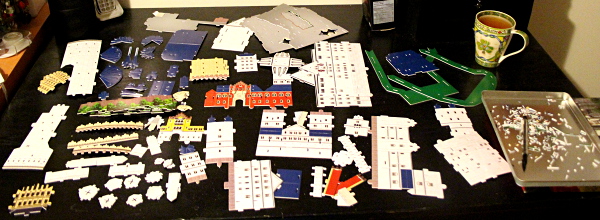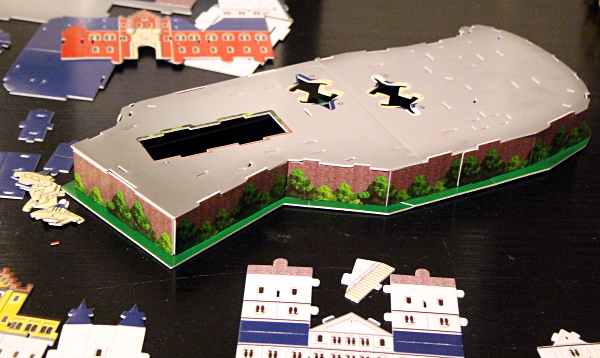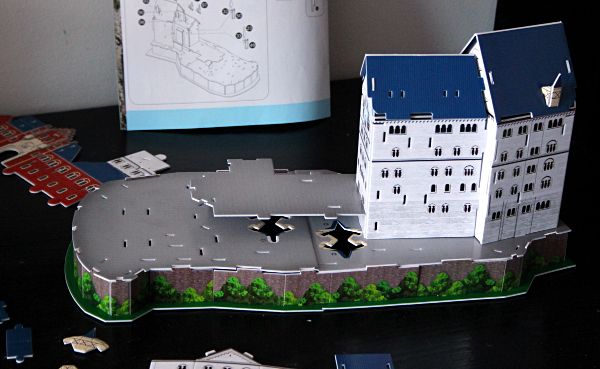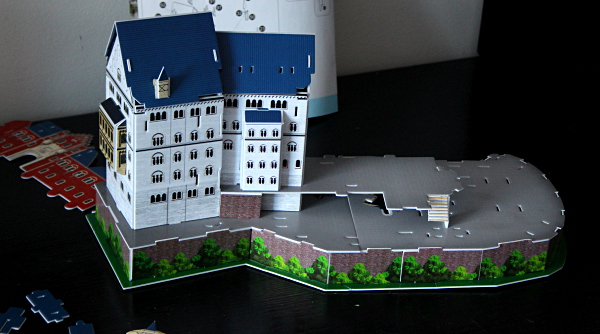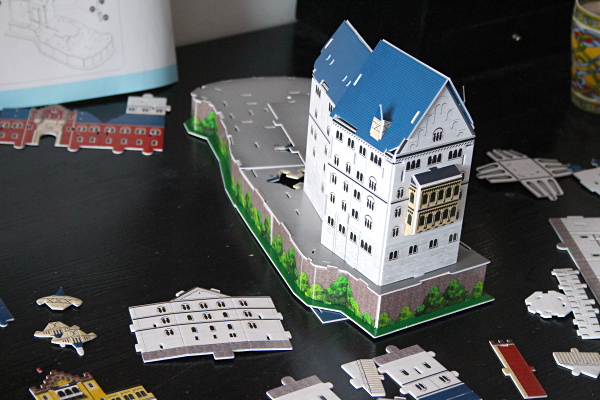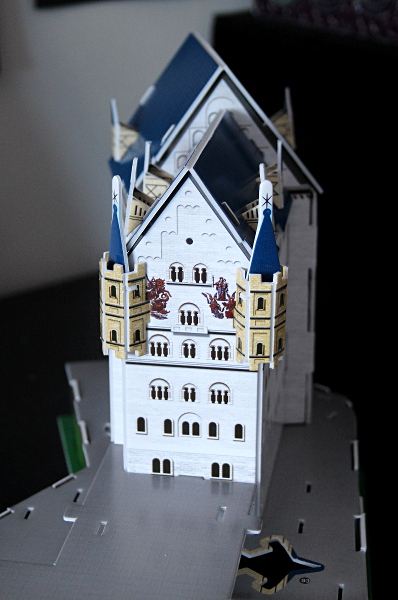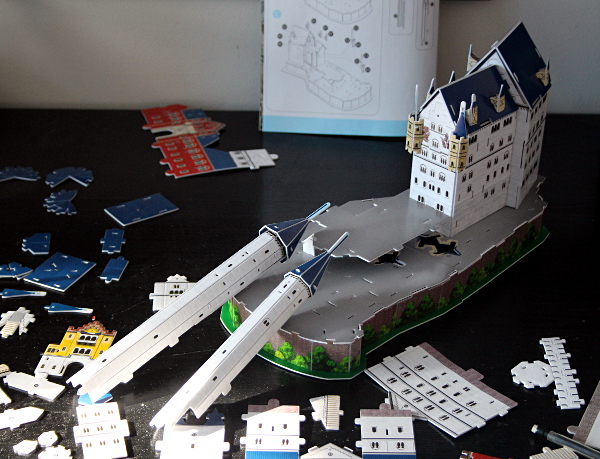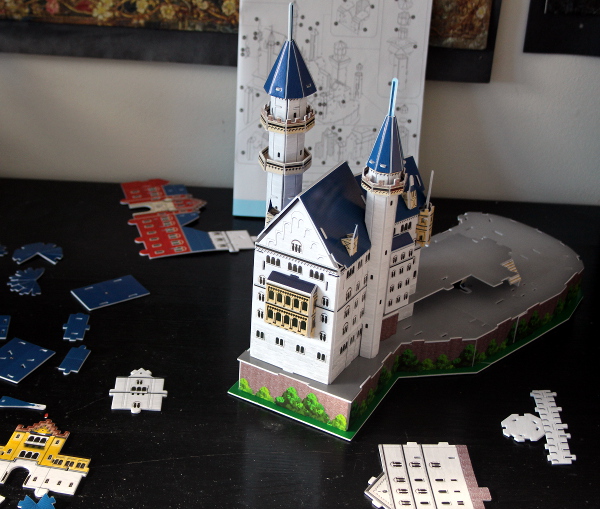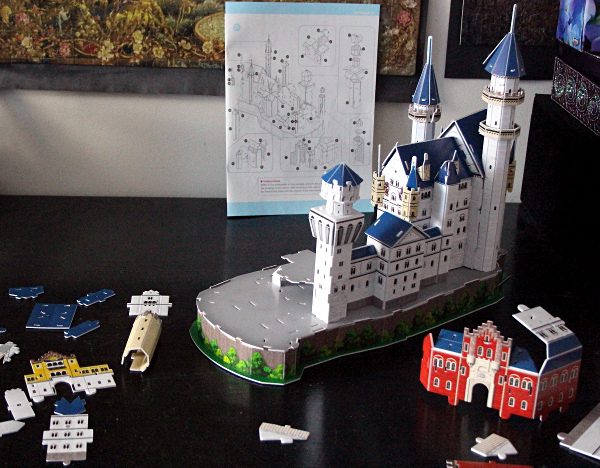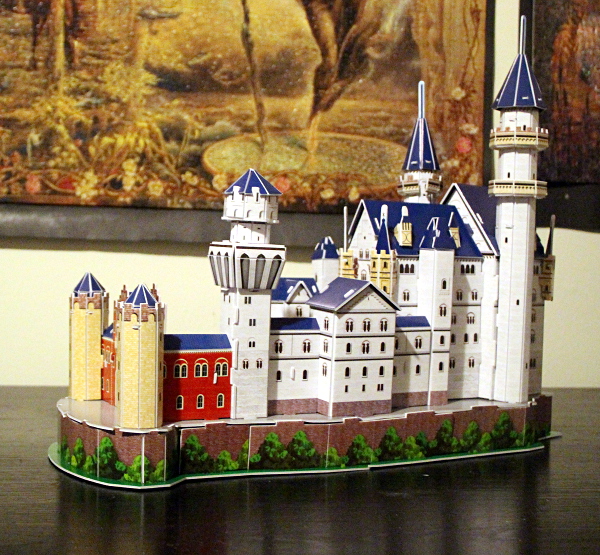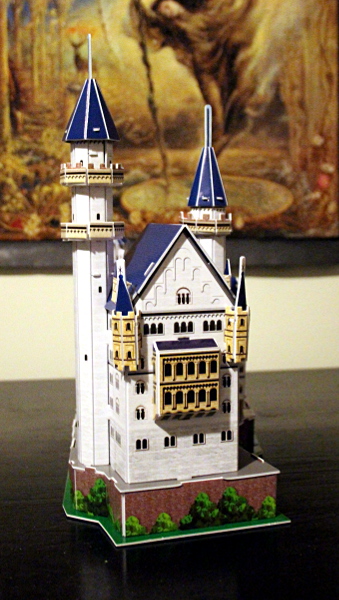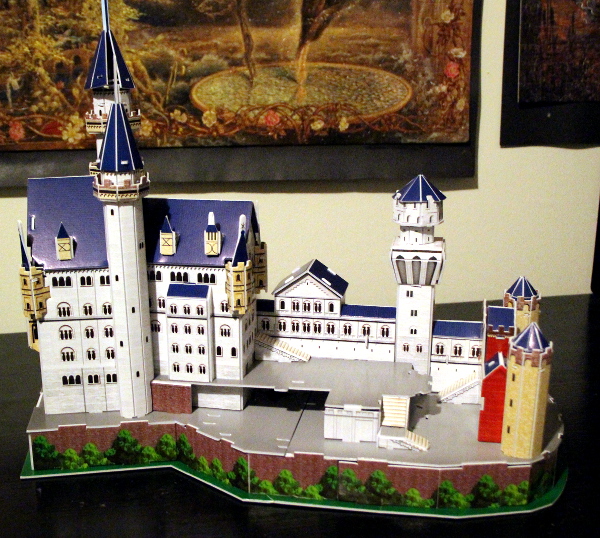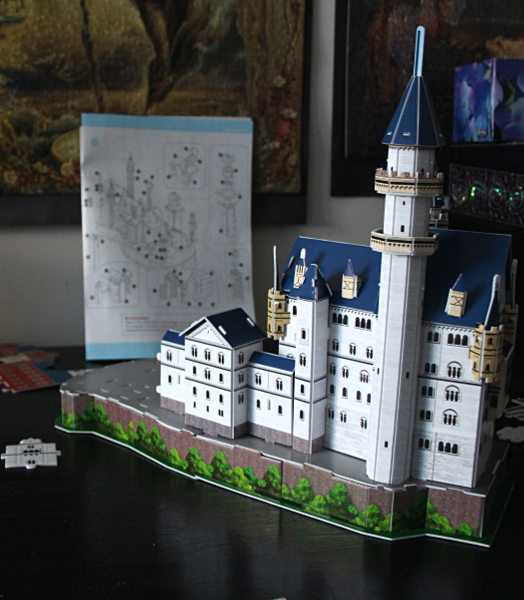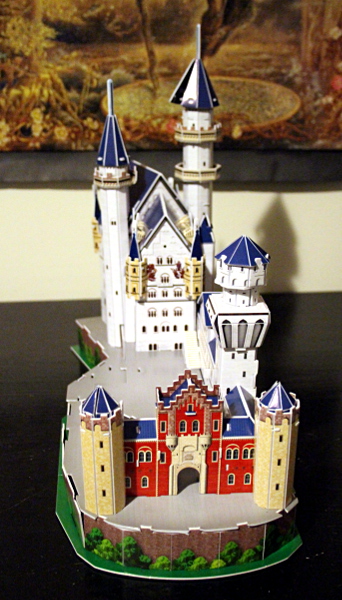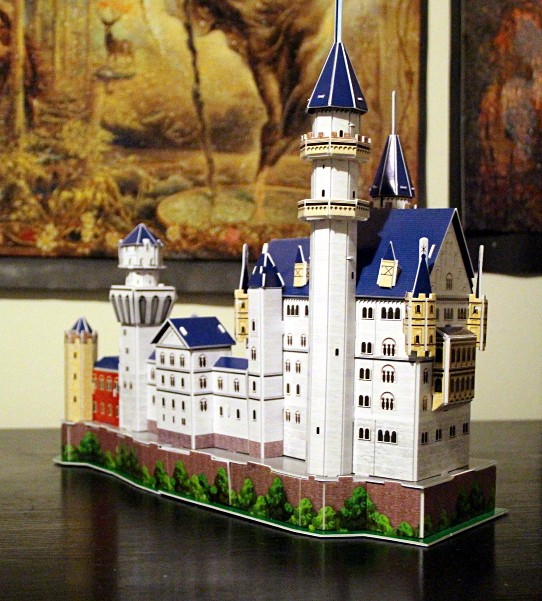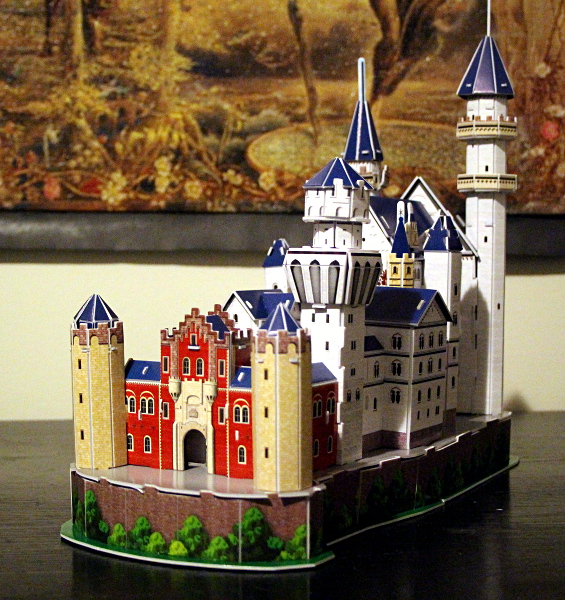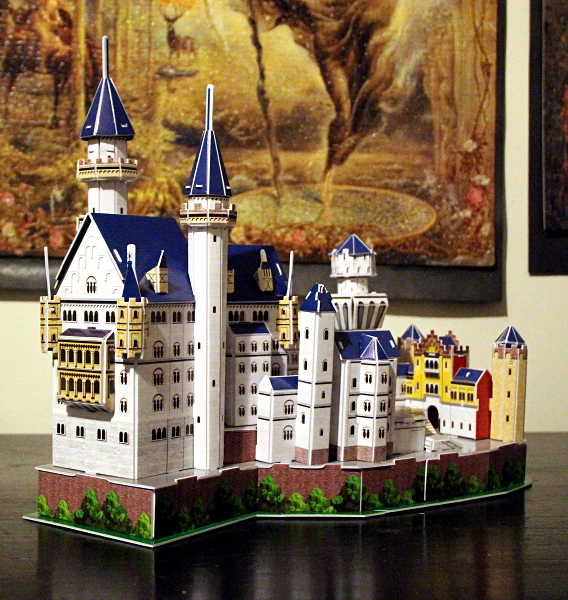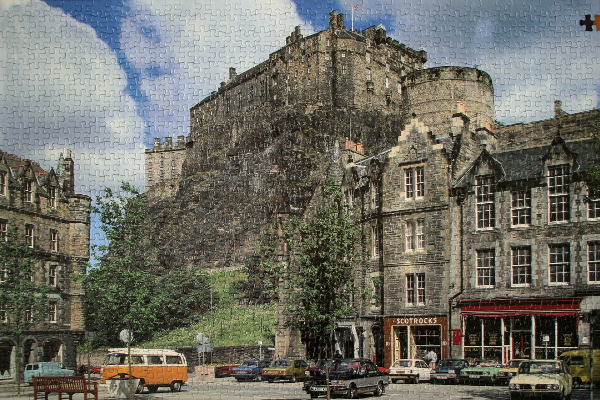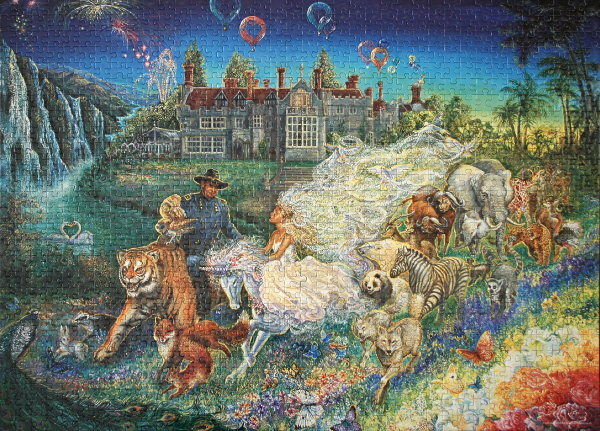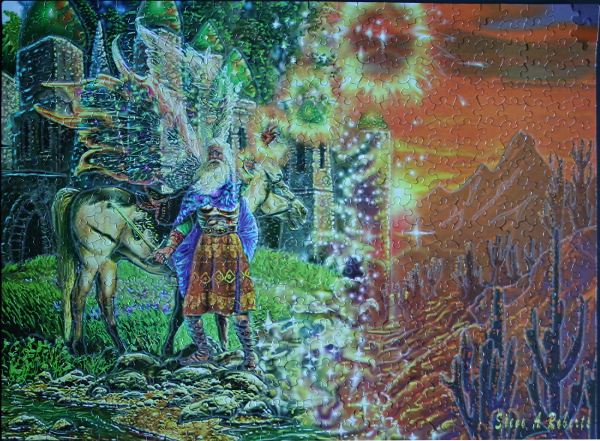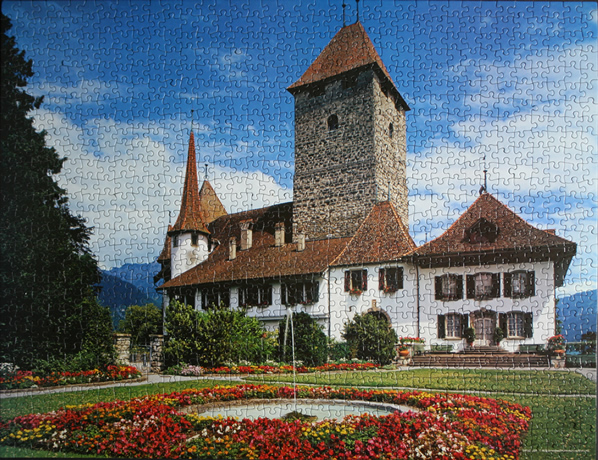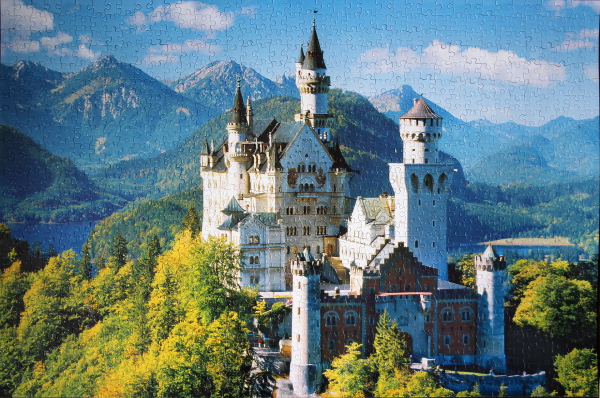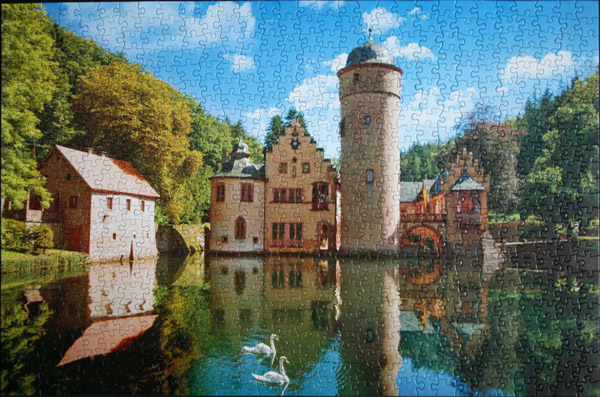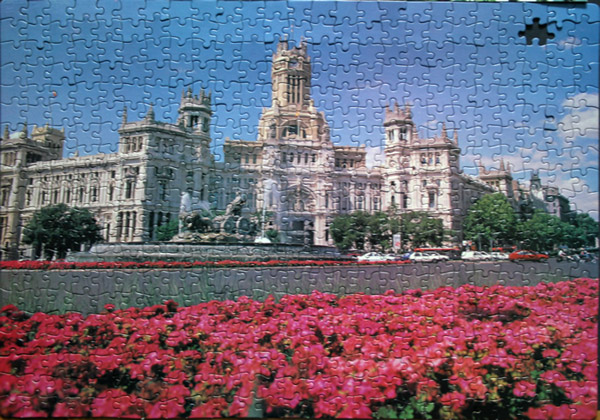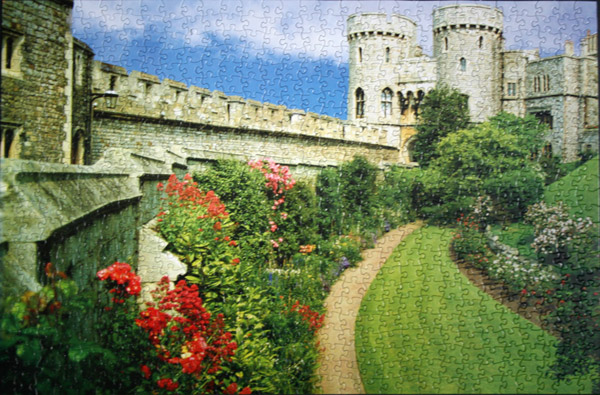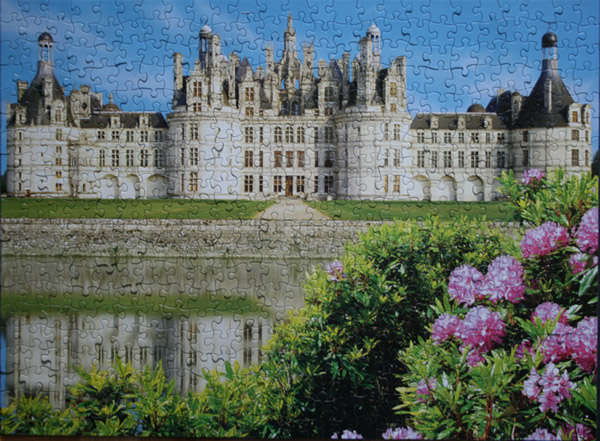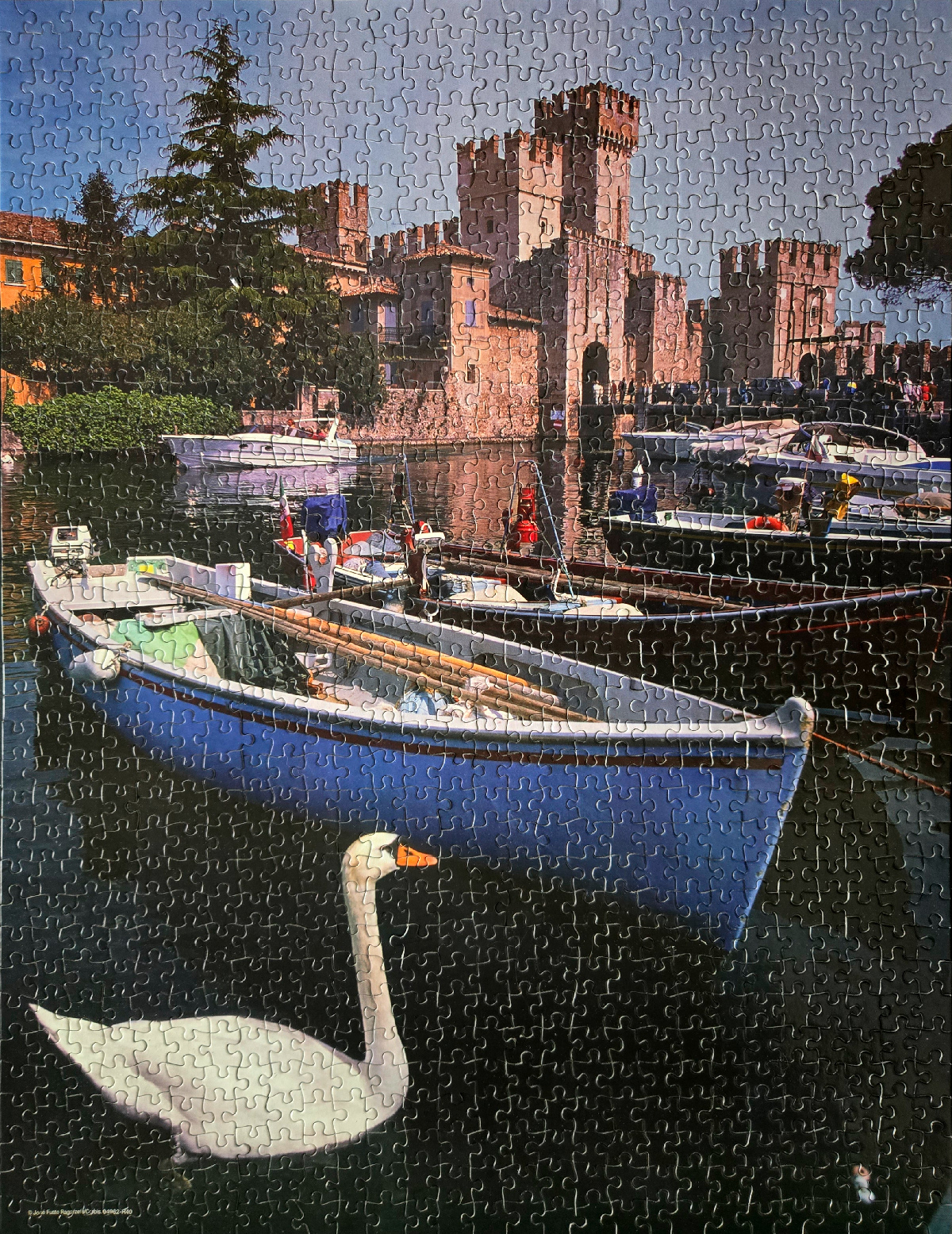
Size: 1000 pieces
Available for purchase on eBay
Dimensions: 51.12 cm x 66.52 cm
Manufacturer: Mega Brands
Photographer: José Fuste Raga
Box: photo
Tag: castle
Dracula in Dr. Seward’s Library
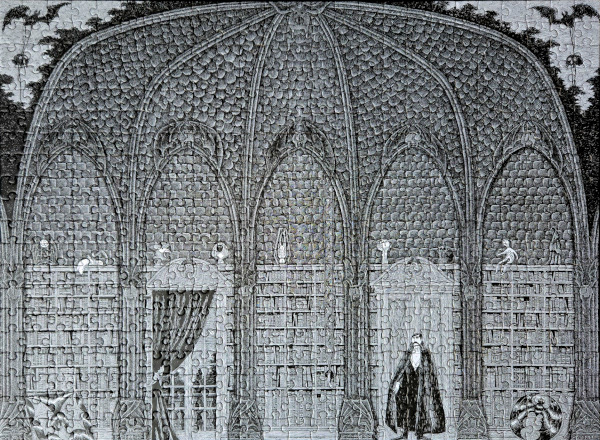
Size: 500 pieces
Available for purchase on eBay
Dimensions: 45.7 cm x 61 cm
Manufacturer: Pomegranate, ISBN: 978-0-7649-6193-9, Item No. AA711
Author: Eward Gorey
Box: photo
Casa Loma
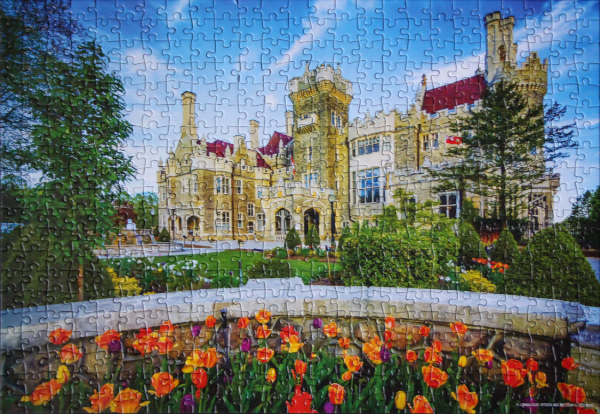
Size: 500 pieces
Available for purchase on eBay
Dimensions: 33.02 cm x 48.26 cm
Manufacturer: The Canadian Group, #20231, Itm./Art. 1231110, 20150MSDG
Photographer: Jon Bilous
Box: photo
The Secret of Bleakdale Abbey
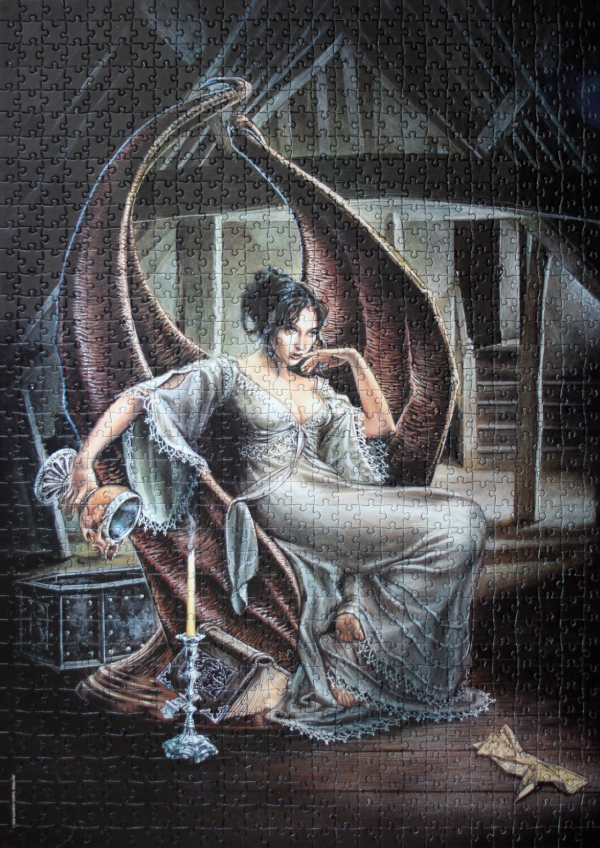
Size: 1000 pieces
Available for purchase on eBay
Dimensions: 47.7 cm x 67.7 cm
Manufacturer: Clementoni, Art. 39111
Artist:
Alchemy Carta, England
Box: photo
Winter at Neuschwanstein Castle
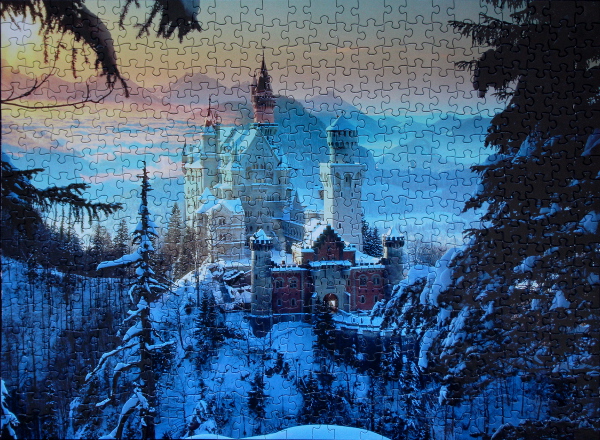
Size: 500 pieces
Dimensions: 48 cm x 36 cm
Manufacturer: TCG, #58805-23
Author: Hans Peter Huber
Puzzle: Another beautiful rendition of Neuschwanstein Castle, this one has a magical feel to it, with the sky in sunset colours and grounds sleeping under the snow.
The easiest place to start is the sky with its many gradients and islands of colour. The castle can come next. The trees and the grounds are a bit more tricky, since there are only shades of blue and black, yet as the puzzle is not big, the challenge is not great.
This puzzle came as part of a package of five 500-piece puzzles.
Egeskov Castle and Gardens

Size: 500 pieces
Dimensions: 48 cm x 36 cm
Manufacturer: TCG, #58805-23
Author: Günter Gräfenhain
Puzzle: Lovely festive puzzle with clusters of bright white, red, yellow flowers, a pond reflecting a bright blue sky, a castle in the background and a wall of green on the right. Fun and bright, pleasure to assemble.
The easiest part to assemble is the top, with the sky, the castle, adn the wall. After that, perhaps the pond border and then – the bright kaleidoscope of flowers.
This puzzle came as part of a package of five 500-piece puzzles.
Puzzle: Neuschwanstein Castle in 3D
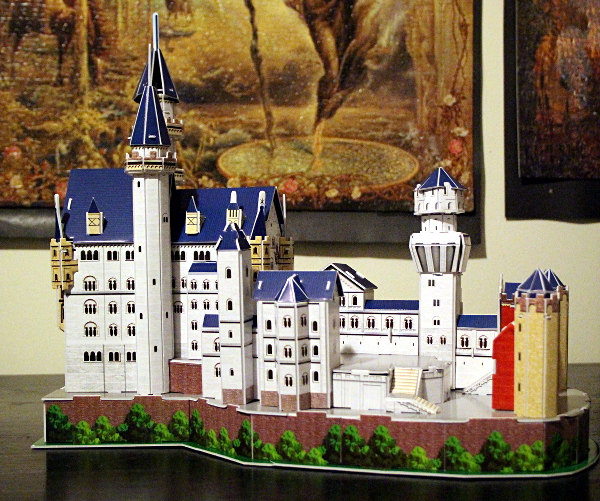 Size: 98 pieces
Size: 98 pieces
Dimensions: 41.5 cm x 18 cm x 33.5 cm
Producer: CubicFun, 3D Puzzle series MC, #MC062h, complexity 5/6
Puzzle: Following the St. Basil’s Cathedral, the Taj Mahal, and the Parliament Buildings of Canada 3D puzzles, I am now perpetually on the lookout for other higher-complexity puzzles made by CubicFun, and my partner found one in a nearby toy store (Mrs. Tiggy Winkles), getting it for me as a surprise the weekend when I was sick.
Here is the box, the booklet (see below for the historical information contained therein) and sheets with puzzle pieces.
I have done this in three stages:
1. Separating all the pieces from the sheets in which they were embedded.
2. Punching out the holes in the pieces (I used a tip of a mechanical pencil).
3. And putting together the puzzle itself. Below are the progress photos:
I have quite enjoyed this puzzle. It is well-made and the castle looks beautiful when assembled.
Notes from the puzzle booklet:
Please note that I have not changed any spelling or grammar.
“The world’s famous architecture we build it. Neuschwanstein.
Neuschwanstein Castle
Neuschwanstein is a 19th-century Bavarian palace on a rugged hill near Hohenschwangau and Füssen in southwest Bavaria, Germany. The palace was commissioned by Ludwig II of Bavaria as a retreat and as a homage to Richard Wagner, the King’s inspiring muse. Although public photography of the interior is not permitted, it is the most photographed building in Germany and is one of the country’s most popular tourist destinations.
Today Neuschwanstein is one of the most popular of all the palaces and castles in Europe. Every year 1.3 million people visit “the castle of the fairy-tale king”. In the summer around 6,000 visitors a day stream through rooms that were intended for a single inhabitant.
The prince was born on the name day of the canonized Louis IX, King of France and founder of the House of Bourbon. Ludwig II was possessed by the idea of a holy kingdom by the Grace of God. In reality he was a constitutional monarch, a head of state with rights and duties and little freedom of action. For this reason he built a fantasy world around him in which – far removed from reality – he could feel he was a real king.
The conception of the palace was outlined by Ludwig II in a letter to Richard Wagner, dated May 13, 1868; “It is my intention to rebuild the old castle ruin at Hohenschwangau near the Pollat Gorge in the authentic style of the old German knights’ castles… the location is the most beautiful one could find, holy and unapproachable, a worthy temple for the divine friend who has brought salvation and true blessing to the world.”
Woodcarving in Ludwig’s bedroom took 14 carpenters 4 1/2 years to complete. The Monarch’s bed is crowned by the most intricate woodcarving and covered with richly Embroider draperies.
Gardons were built behind the Neuschwanstein Castle.
The Throne Room was created as the Grail-Hall of Parsifal. It was designed in elaborate Byzantine style. It was inspired by the Hagia Sophia in Constantinople (now Istanbul), the 2 story throne room with its series of pillars of imitation porphyry and lapis lazuli, was completed in the year of the Kings death in 1886.
The throne room, which features a glass gem-encrusted chandelier; all Twelve Apostles and six canonised kings are painted on the wall that surrounds the pedestal for the throne – the actual throne was never finished.
Just imagine a mysterious stalactite cavern just between the Living Room and the Study Ludwig II. Magnificent and charming!
The region is full of mountains, forests, meadows, lakes, cycle paths… It proposes more you can ever think possible.
Today Neuschwanstein is one of the most popular of all the palaces and castles in Europe. It is also nominated as one of the New Seven Wonders of the World.
Every year 1.3 million people visit “the castle of the fairy-tale king”. In the summer around 6,000 visitors a day stream through rooms that were intended for a single inhabitant.” [Puzzle booklet]
Puzzle: Unknown Castle
Size: 1000 pieces, 1 missing
Dimensions: 73 cm x 48.57 cm
Producer: Sure-Lox, The Canadian Group
Puzzle: This lovely castle and the old buildings around it make for a challenging puzzle. There are many ways to approach it. The easiest regions to start would be the sky and clouds, the bright cars and storefronts at the bottom, the green grass region and the fence at its bottom, and the borders of the buildings and the sky. The larger windows of the building on the right can help the assembly of that part of the puzzle. The sky and clouds are distinct enough from the rest of the puzzle and can be filled in relatively easily. The Trees and shrubs can follow. The castle has a large region of a somewhat-uniform grey pattern, making it not so easy to assemble, but it makes for an interesting challenge.
Notes: I no longer have the box, so if you know of the series this puzzle is from and the building it portrays, please let me know.
Puzzle: Josephine Wall – Fantasy Wedding
Size: 1000 pieces
Dimensions: 67 cm x 48 cm
Producer: RoseArt, Masterworks series
Artist: Josephine Wall
Puzzle: A simple puzzle to do, due to its many distinct elements. One can start really anywhere – good places are the rainbow-coloured flowers in the bottom right, the white of the bride and her horse, the balloons and the sky, palm trees, waterfall, and river. The building and various animals can follow, and the rest is trivial.
Notes: “At a fantasy wedding there is no need of a limousine when the bride can arrive on a pure white unicorn, and the groom on a powerful striped mount.With attendants from the jungles and plains, the happy young couple set out on their journey through life together, surrounded by all the things that have meant so much to them. What a magical day, one never to be forgotten!” [Josephine Wall site]
Puzzle: Neuschwanstein Castle, Bavaria, Germany
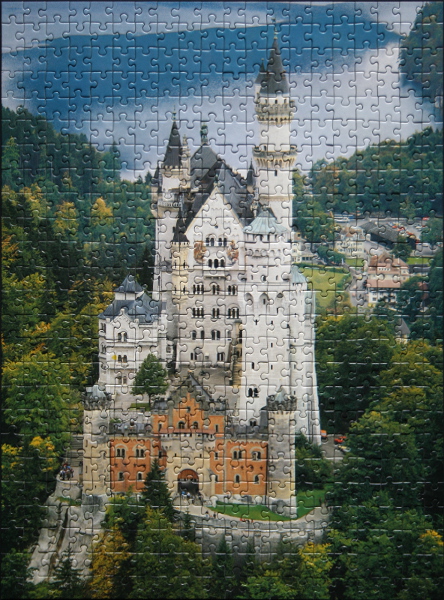
Size: 500 pieces
Dimensions: 36.0 cm x 49.3 cm
Producer: Ravensburger, Otto Maier Verlag, 1984, #14 138 8
Puzzle: Yet another puzzle of this beautiful castle, in addition to the 500-piece, the 1000-piece, and another 500-piece puzzles I’ve assembled previously. This one features clear photography, good angle, and pieces that fit together well. The easiest places to start are the sky and clouds, the orange part of the castle, the green of the grass, the boundary between the castle and the sky, and the sky and the trees, followed by the rest of the castle. The houses in the background and the trees around the castle can then follow.
Puzzle: Ludwig’s Castle, Bavaria, Germany
Size: 500 pieces
Dimensions: 45.5cm x 35.5cm
Producer: Leap Year
Puzzle: Not a bad puzzle as far as the picture goes, but the manufacturing process appears to be faulty: many pieces are bent out of shape and do not fit together well, taking away from the assembling experience. The puzzle itself is relatively easy to put together: the sky, the fields, and the castle are good places to start. The trees are a little more challenging, so good lighting is good to have for assembling the bottom part. Overall, nothing special: showing more castle and less of the tree area would make this puzzle more enjoyable. There are better puzzles depicting this castle, I’ve previously put together two: in 1000 pieces and 500 pieces.
Notes: Neuschwanstein Castle is a 19th-century Romanesque Revival palace on a rugged hill above the village of Hohenschwangau near Füssen in southwest Bavaria, Germany. The palace was commissioned by Ludwig II of Bavaria as a retreat and as a homage to Richard Wagner. Ludwig paid for the palace out of his personal fortune and by means of extensive borrowing, not with Bavarian public funds. [Wiki]
Puzzle: Alter Terrain by Steve A. Roberts
Size: 550 pieces
Dimensions: 61 cm x 46 cm
Artist: Steve A. Roberts
Producer: Ceaco, Glow in the Dark series, 2003, #2333-24
Puzzle: Simple puzzle to do, the pieces fit unambiguously. Some good regions to start are the wizard’s face and clothing, the horse, the border between the two terrains, the cacti, the fortress, and the spheres of light. The grass, the rocks, the mountain peak, and the orange sky can follow, leaving a few pieces to fill in.
Notes: Change Terrain is an Uncommon Instant Spell belonging to the Nature Magic realm. It may only be cast on the overland map. For the base Casting Cost of 50, it will change a targeted tile from one terrain type to another. Most terrain tiles are shifted one “step” closer to Grassland, and Grassland may be changed back into Forest. Several types of terrain, including Oceans, may not be targeted. The effect is permanent and does not require an Upkeep Cost to maintain. [Master of Magic wiki]
Puzzle: Chateau Chenonceaux, France
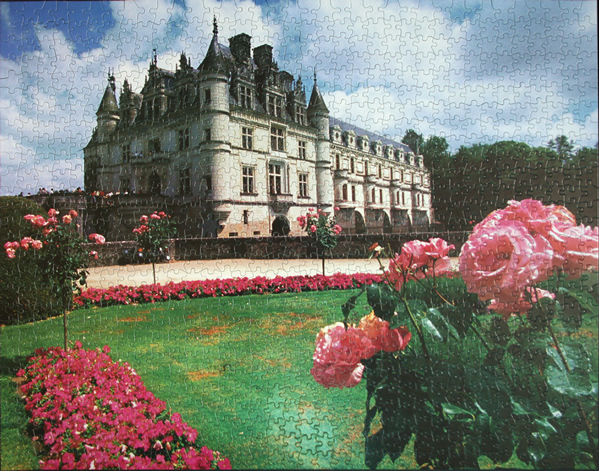
Size: 1000 pieces
Dimensions: 69.85cm x 54.61cm
Producer: Golden, Guild Puzzle, Tony Craddock / Tony Stone, ISBN: 0-307-04710-5
Notes: The Chateau de Chenonceau is a manor house near the small village of Chenonceaux, in the Indre-et-Loire departement of the Loire Valley in France. It was built on the site of an old mill on the River Cher, sometime before its first mention in writing in the 11th century. The current manor was designed by the French Renaissance architect Philibert Delorme.
An architectural mixture of late Gothic and early Renaissance, Chateau de Chenonceau and its gardens are open to the public. Other than the Royal Palace of Versailles, Chenonceau is the most visited chateau in France. [Wiki]
Puzzle: La Roche Courbon Castle, France
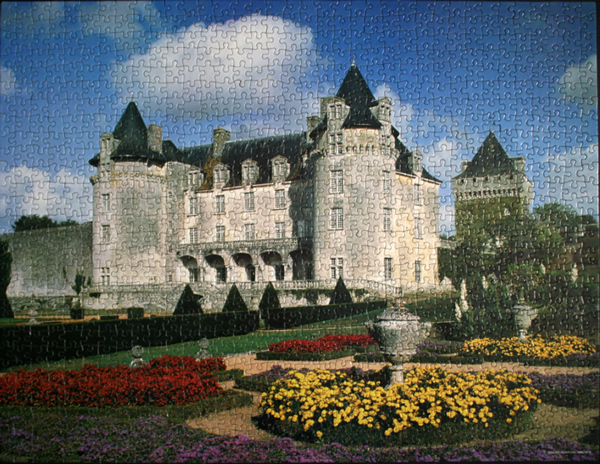
Size: 1000 pieces
Dimensions: 51.12cm x 66.52cm
Producer: Big Ben, MB Puzzles, Hasbro, 2007
Notes: Chateau de la Roche Courbon is a large chateau, developed from an earlier castle, in the Charente-Maritime departement of France. It is in the commune of Saint-Porchaire between Saintes and Rochefort.
A castle was built around 1475 by Jehan de Latour, on site which had been inhabited since prehistoric times. In the 17th century, the Courbon family, which had occupied the castle for two centuries, transformed it into a more comfortable residence. More alterations were made in the 18th century, but it was eventually sold in 1817 and then abandoned. It was purchased in 1920 by Paul Chenereau, who restored the chateau and its gardens. The chateau is still owned and inhabited by his descendants.
The gardens include orchard, flower garden, geometrical flower beds and lawns surrounding a small lake (‘mirror pool’). The River Bruant flows through the gardens, feeding the water features. Beyond that, an ornamental staircase leads to higher ground, on the far side of the river. [Wiki]
Puzzle: Berner Oberland, Switzerland
Size: 1000 pieces
Dimensions: 51.12cm x 66.52cm
Producer: Big Ben, MB Puzzles, 2008, #04962-U24
Notes: The Bernese Oberland (Bernese Highlands) is the higher part of the canton of Bern, Switzerland, in the southern end of the canton: The area around Lake Thun and Lake Brienz, and the valleys of the Bernese Alps. [Wiki]
Beautiful photos of the region: http://www.berneroberland.be/
Puzzle: Neuschwanstein Castle
Size: 1000 pieces
Dimensions: 73cm x 48.5cm
Producer: The Canadian Group, Sure-Lox, Photo Gallery 10 puzzle pack, #40617-13
Notes: I have put together another puzzle of the Neuschwanstein Castle before, 500 pieces.
The inspiration for the construction of Neuschwanstein came from two journeys [of Ludwig II] in 1867: one in May to the reconstructed Wartburg near Eisenach, another in July to the Chateau de Pierrefonds, which Eugene Viollet-le-Duc was transforming from a ruined castle into a historistic palace.
The king saw both buildings as representatives of a romantic interpretation of the Middle Ages as well as the musical mythology of his friend Richard Wagner. Wagner’s operas Tannhauser and Lohengrin had made a lasting impression on him.
In February 1868, Ludwig’s grandfather Ludwig I died, freeing the considerable sums that were previously spent on the abdicated king’s appanage. This allowed him to start the architectural project of building a private refuge in the familiar landscape far from the capital Munich, so that he could live his idea of the Middle Ages. [Wiki]
Puzzle: Castle Mespelbrunn
Size: 750 pieces
Dimensions: 59.7 cm x 39.4 cm
Producer: The Canadian Group, Sure-Lox, Photo Gallery 10 puzzle pack, #43550-26
Notes: Mespelbrunn Castle is a medieval moated castle on the territory of the town of Mespelbrunn, between Frankfurt and Wurzburg, built in a remote tributary valley of the Elsava valley, within the Spessart forest. One of the most visited water castles in Germany, it is frequently featured in tourist books.
In 1957 Mespelbrunn Castle was one of the locations of the German film Das Wirtshaus im Spessart (The Spessart Inn, 1958), based on a fairy tale by Wilhelm Hauff. [Wiki]
Puzzle: Madrid, Spain
Size: 500 pieces, 1 missing
Dimensions: 37 cm x 52 cm
Producer: GPC Puzzles, Regency Collection, #1550-08
Notes: The Plaza de Cibeles is a square with a neo-classical complex of marble sculptures with fountains that has become an iconic symbol for the city of Madrid. It sits at the intersection of Calle de Alcala (running from east to west), Paseo de Recoletos (to the North) and Paseo del Prado (to the south). Plaza de Cibeles was originally named Plaza de Madrid, but in 1900, the City Council named it Plaza de Castelar, which was eventually replaced by its current name.
The most prominent of the buildings at the Plaza de Cibeles is the Cibeles Palace (formerly named Communications Palace). The cathedral-like landmark was built in 1909 by Antonio Palacios as the headquarters of the postal service. This impressive building was home to the Postal and Telegraphic Museum until 2007 when the landmark building became the Madrid City Hall. [Wiki]
Puzzle: Windsor Castle, Britain
Size: 750 pieces
Dimensions: 59.7 cm x 39.4 cm
Producer: The Canadian Group, Sure-Lox, Photo Gallery 10 puzzle pack
Notes: Windsor Castle is a medieval castle and royal residence in Windsor in the English county of Berkshire, notable for its long association with the British royal family and for its architecture. The original castle was built after the Norman invasion by William the Conqueror. Since the time of Henry I it has been used by a succession of monarchs and is the longest-occupied palace in Europe. The castle’s lavish, early 19th-century State Apartments are architecturally significant, described by art historian Hugh Roberts as “a superb and unrivalled sequence of rooms widely regarded as the finest and most complete expression of later Georgian taste”. [Wiki]
Puzzle: Springtime at Chambord
Size: 500 pieces
Dimensions: 48.26cm x 35.56cm
Producer: The Canadian Group, Sure-Lox, Photo Gallery 10 puzzle pack
Notes: I have previously put together another puzzle of Chamboard Château, 1000: http://fingeringzen.com/puzzles/puzzle-chambord-chateau.
Chambord is the largest château in the Loire Valley; it was built to serve as a hunting lodge for François I, who maintained his royal residences at Château de Blois and Château d’Amboise. The original design of the Château de Chambord is attributed, though with several doubts, to Domenico da Cortona. Some authors claim that the French Renaissance architect Philibert Delorme had a considerable role in the château’s design, and others have suggested that Leonardo da Vinci may have designed it. [Wiki]






